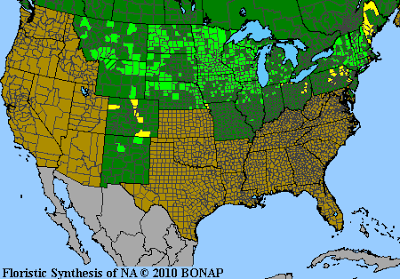*Being at work, I can't very well have my camera equipment with me in the field so all the photos from this post were snapped with my iPhone. It did its job well but I'm looking forward to getting back out there with the 'real' stuff to better capture the site and plants.*
This morning found your blogger working in northwestern Miami county at the Stillwater River prairie nature preserve monitoring and updating some rare plant records from the area. I wrote about the place in an earlier post mentioning how "lacking" my home county seemed to be of the botanically rare and extraordinary. I had my eyes peeled for my target species of timid sedge (Carex timida) and Wood's hellebore (Veratrum woodii) among the thick carpet of spring ephemerals in peak bloom all throughout the pristine riparian woodland. Large-flowered trillium (Trillium grandiflorum), shooting star (Dodecatheon media), wild hyacinth (Cammasia scilloides), and wild geranium (Geranium maculatum) numbered in the hundreds, sitting under the gloomy shadows of the leafed out canopy and drizzly skies above.
 |
| Clump of the state-threatened Sprengel's sedge (Carex sprengelii) |
As I carefully waded through the sea of flowers my eyes managed to catch a clump of a suspicious looking sedge not twenty feet from the river's banks. I sat my materials down and took a closer look at the fruiting culms but could not pinpoint the species off the top of my head despite it being quite conspicuous and unique-looking for a sedge.
 |
| Long-beaked sedge (Carex sprengelii) |
The drooping fruit clusters had perigynia with very long beaks that gave it a prickly appearance. It was unlike any other species of sedge I'd ever come across before so it was off to my trusty Illustrated Flora of Illinois: Carex book to see if its identity lay within. After running it through the key and taking a gander at some of the line drawings, I came to the conclusion of Carex sprengelii. But that just didn't seem to make much sense given its known range and rarity in our state.
 |
| North American distribution of Carex sprengelii (courtesy BONAP) |
Carex sprengelii is a state-threatened species that until now had only ever been collected and known to occur in a handful of northeastern and northwestern counties. Looking at the natural distribution map above it's not hard to notice Miami county in the west-central part of the state to be quite disjunct from its two population centers in Ohio.
 |
| Long-beaked sedge (Carex sprengelii) |
I ran it by the description in the book one last time: drooping fruit spikes; round and nerveless perigynia with a long beak; culm bases very fibrous with last year's leaf growth...all there! I called up Rick Gardner who is my boss, good friend, and the state's chief botanist who's well-known specialty is the Carex genus. If anyone could confirm my finding it was him. After describing it and looking over the photos I emailed he confirmed it was indeed Carex sprengelii! He even mentioned that his first rare plant find when he started with the Division of Natural Areas and Preserves (DNAP) was this very sedge in eastern Ohio. Funny how it ended up being my first (and hopefully not last!) rare plant find after starting with DNAP.
 |
| Long-beaked sedge (Carex sprengelii) |
I surveyed the site for more but the one square yard patch of it was all I could find. It was in excellent shape and looked very healthy with over 50 flowering culms. I read where it can occur in a variety of habitats and stream terraces in riparian woodlands was one of them; especially when associated with limestone bedrock/soils. I took a lot of joy in writing down and recording the information for the population and habitat. As a proud native son of Miami county it felt great to have it and my love for botany come together in such a nice way. Personally adding to the recognized diversity of Miami county's vascular flora is something I didn't expect to do but sure glad I could! Here's hoping this is a sign of fun times and things to come this summer!

Andrew, nobody can nose out rare plants the way you can. And what a find! Only a fellow nature nut could understand what a thrill it is to discover something as rare as this. Congratulation!
ReplyDeleteCongratulations, Andrew, on finding a new population of this rare sedge! Good eye! Great detective work!
ReplyDelete